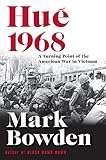Huế 1968 : a turning point of the American war in Vietnam / Mark Bowden.
Material type: TextPublisher: New York : Atlantic Monthly Press, [2017]Edition: First editionDescription: 610 pages : illustrations, maps ; 24 cmContent type:
TextPublisher: New York : Atlantic Monthly Press, [2017]Edition: First editionDescription: 610 pages : illustrations, maps ; 24 cmContent type: - text
- unmediated
- volume
- 9780802127006 (hardcover)
- DS557.8.H83 B68 2017
| Item type | Current library | Collection | Call number | Copy number | Status | Barcode | |
|---|---|---|---|---|---|---|---|
 Books
Books
|
Zayed Military University General Stacks | General Collection | DS557.8.H83 B68 2017 (Browse shelf(Opens below)) | C. 1 | Available | 22696 |
Browsing Zayed Military University shelves,Shelving location: General Stacks,Collection: General Collection Close shelf browser (Hides shelf browser)

|

|

|

|

|

|

|
||
| DS383.5 .A3 R278 2021 Geopolitics of the Pakistan - Afghanistan Borderland / | DS553.7 .R777 2023 France's War In Indochina : No. 45 Volume 1: the tiger versus the elephant, 1946-1949 / | DS557.7 .H357 2019 Vietnam : An epic history of a tragic war / | DS557.8.H83 B68 2017 Huế 1968 : a turning point of the American war in Vietnam / | DS563 .B474 2022 Experience Thailand/ | DS608.8 .J79 2022 Pocket Singapore : top experiences, local life / | DS779.47 .K82 2017 China and the BRICS: setting up a different kitchen / |
Includes glossary of Vietnamese terms and index.
The infiltration -- The fall of Huế -- Futility and denial -- Counterattack in the Triangle and disaster at La Chu -- Sweeping the Triangle -- Taking back the Citadel.
In mid-1967, the North Vietnam leadership had started
planning an offensive intended to win the war in a single
stroke. Part military action and part popular uprising,
the effort included attacks across South Vietnam, but the
most dramatic and successful would be the capture of Hûé,
the country's intellectual and cultural capital. At 2:30
a.m. on January 31, the first day of the Lunar New Year
(called Tet), ten thousand National Liberation Front
troops descended from hidden camps and -- led by locals
like eighteen-year-old village girl and Viet Cong member
Che Thi Mung -- surged across the city of 140,000. By
morning, all of Hûé was in Front hands save for two small
military outposts. The American commanders in country and
politicians in Washington refused to believe the size and
scope of the Front's presence. Captain Chuck Meadows was
ordered to lead his 160-marine Golf Company in the first
attempt to reenter Hûé later that day. Facing thousands
of entrenched enemy troops, he reported: "We are outgunned
and outmanned." After several futile and deadly days,
Lieutenant Colonel Ernie Cheatham would finally come up
with a strategy to retake the city, block by block and
building by building, in some of the most intense urban
combat since World War II. With unprecedented access to
war archives in the United States and Vietnam and
interviews with participants from both sides, Bowden
narrates each stage of this crucial battle through
multiple points of view. Played out over twenty-four days
of terrible fighting and ultimately costing more than ten
thousand combatant and civilian lives, the Battle of Hue
was by far the bloodiest of the entire war. When it ended,
the American debate over the war was never again about
winning, only about how to leave.
There are no comments on this title.
